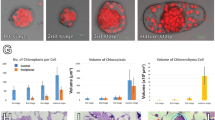Abstract
Fossil cytoplasm is attracting increasing attention in the fossil record, and ultrastructures in plant cells are revealing new aspects of ancient life. Chloroplasts have been previously reported in fossil plants in the US, Canada, and Russia. Here, we report on fossil chloroplasts with internal ultrastructure in a fossil leaf of Nelumbo changchangensis from the Eocene of Hainan Island, South China. The chloroplasts in this fossil demonstrate great similarity to their counterparts in living relative as well as those in the previous reports. The well-preserved chloroplasts in plant fossils call for more attention to ultrastructures and the fossilizing mechanisms of cytoplasm.




Similar content being viewed by others
References
Golenberg EM, Giannasi DE, Clegg MT, Smiley CJ, Durbin M, Henderson D, Zurawski G (1990) Chloroplast DNA sequence from a Miocene Magnolia species. Nature 344:656–658
Grant BR, Borowitzka MA (1984) The chloroplasts of giant-celled and coenocytic algae: biochemistry and structure. Bot Rev 50:267–307
He X, Shen R, Jin J (2010) A new species of Nelumbo from south China and its palaeoecological implications. Rev Palaeobot Palynol 162:159–167
Kim S, Soltis DE, Soltis PS, Suh Y (2004) DNA sequences from Miocene fossils: an ndhF sequence of Magnolia latahensis (Magnoliaceae) and an rbcL sequence of Persea pseudocarolinensis (Lauraceae). Am J Bot 91:615–620
Niklas KJ (1982) Differential preservation of protoplasm in fossil angiosperm leaf tissues. Am J Bot 69:325–334
Niklas KJ (1983) Organelle preservation and protoplast partitioning in angiosperm leaf tissues. Am J Bot 70:543–548
Niklas KJ, Brown RM (1981) Ultrastructural and paleobiochemical correlations among fossil tissue from the St. Maries River (Clarkia) area, Northern Idaho, USA. Am J Bot 68:332–341
Niklas KJ, Brown RM, Santos R, Vian B (1978) Ultrastructure and cytochemistry of Miocene angiosperm leaf tissues. Proc Natl Acad Sci USA 75:3263–3267
Niklas KJ, Brown RMJ, Santos R (1985) Ultrastructural states of preservation in Clarkia angiosperm leaf tissues: implications on modes of preservation. In: Smiley CJ (ed) Late Cenozoic History of the Pacific Northwest. American association for the advancement of science, Pacific Division, San Francisco, pp 143–159
Ozerov IA, Zhinkina NA, Efimov AM, Machs EM, Rodionov AV (2006) Feulgen-positive staining of the cell nuclei in fossilized leaf and fruit tissues of the lower Eocene Myrtaceae. Bot J Linn Soc 150:315–321
Poinar HN, Melzer RR, Poinar GO (1996) Ultrastructure of 30–40 million year old leaflets from Dominican amber (Hymenaea protera, Fabaceae: angiospermae). Experimentia 52:387–390
Schoenhut K (2005) Environmental implications of the preservation of chloroplast ultrastructure in Eocene Metasequoia leaves. Paleobiology 31:424–433
Schoenhut K, Vann DR, LePage BA (2004) Cytological and ultrastructural preservations in Eocene Metasequoia leaves from the Canadian High Arctic. Am J Bot 91:816–824
Scott AC (2001) Preservation by fire. In: Briggs DEG, Crowther PR (eds) Palaeobiology II. Blackwell Science, Malden, pp 277–280
Vikulin SV (1999) The Eocene and Early Oligocene floras of the Russian Plain and their relation to the palaeofloras of Central Europe. Acta Palaeobotanica 2:429–445
Wang X (2004) Plant cytoplasm preserved by lightning. Tissue Cell 36:351–360
Wang X (2007) High temperature as a mechanism for plant cytoplasm preservation in fossils. Acta Geol Sinica 81:183–193
Wang X, Cui J (2007) The first observation on plant cell fossils in China. Acta Geol Sinica 81:16–22
Wang X, Liu W, Cui J, Du K (2007) Palaeontological evidence for membrane fusion between a unit membrane and a half-unit membrane. Mol Membr Biol 24:496–506
Wang X, Yu J, Fang X (2008) An AFM observation on fossil cytoplasm. Acta Geologica Sinica 82:1141–1145
Wang X, Du K, Yi T, Jin J (2010) Cytoplasmic remains in an Eocene fossil stem. IAWA J 31:363–367
Wang X, Liu W, Du K (2011a) Palaeontological evidence of membrane relationship in step-by-step membrane fusion. Mol Membr Biol 28:115–122
Wang X, Yuan X, Zhou C, Du K, Gong M (2011b) Anatomy and plant affinity of Chuaria. Chin Sci Bull 56:1256–1261
Wu Z-Y, Tang Y-C, Lu A-M, Chen Z-D, Li D-Z (2003) The families and genera of angiosperms in China, a comprehensive analysis. Science Press, Beijing
Zhilin SG, Yakovleva OV (1994) On the preservation of anatomical and ultrathin structures of the leaf compressions of Eucommia palaeoulmoides (Eucommiaceae) from the Miocene in Kazakhstan. Botanicheskii Zhurnal 79:1–8
Acknowledgments
We would like to thank Ms. Wang Chunzhao and Ms. He Cuiling for their help during this study. This research is supported by the National Basic Research Program of China (973 Program 2012CB821901), Knowledge Innovation Program of the Chinese Academy of Sciences (KZCX2-YW-154), the National Natural Science Foundation of China (41210001, 40772006, 40972011), and the State Key Laboratory of Palaeobiology and Stratigraphy, Nanjing Institute of Geology and Palaeontology Programs (20102108, 20101104, 123110). We are grateful to the graduate students of Sun Yat-sen University for their collaboration in the fieldwork on Hainan Island. We also thank Ms. Margaret Joyner at University of Florida for improving the manuscript.
Author information
Authors and Affiliations
Corresponding author
Rights and permissions
About this article
Cite this article
Wang, X., Liu, W., Du, K. et al. Ultrastructure of chloroplasts in fossil Nelumbo from the Eocene of Hainan Island, South China. Plant Syst Evol 300, 2259–2264 (2014). https://doi.org/10.1007/s00606-014-1056-2
Received:
Accepted:
Published:
Issue Date:
DOI: https://doi.org/10.1007/s00606-014-1056-2




